A Comprehensive Analysis of Coca-Cola's Innovation Strategies
VerifiedAdded on 2023/01/23
|11
|2634
|55
Report
AI Summary
This report provides a detailed analysis of The Coca-Cola Company's innovation strategies, examining its marketing approaches, manufacturing processes, and corporate structure. The report explores how Coca-Cola leverages marketing strategies to connect with its target audience, emphasizing emotional branding and creative content. It also delves into the evolution of its manufacturing processes, highlighting the introduction of the Coca-Cola Freestyle machine and its impact on data collection and supply chain management. Furthermore, the report discusses Coca-Cola's corporate culture, emphasizing teamwork, employee empowerment, and its commitment to human rights. The conclusion summarizes the company's innovative techniques and strategies, emphasizing their role in Coca-Cola's continued success and suggesting areas for improvement, particularly in health regulations and the zero-calorie drinks line. The PlantBottle packaging is also discussed as a recent innovation.
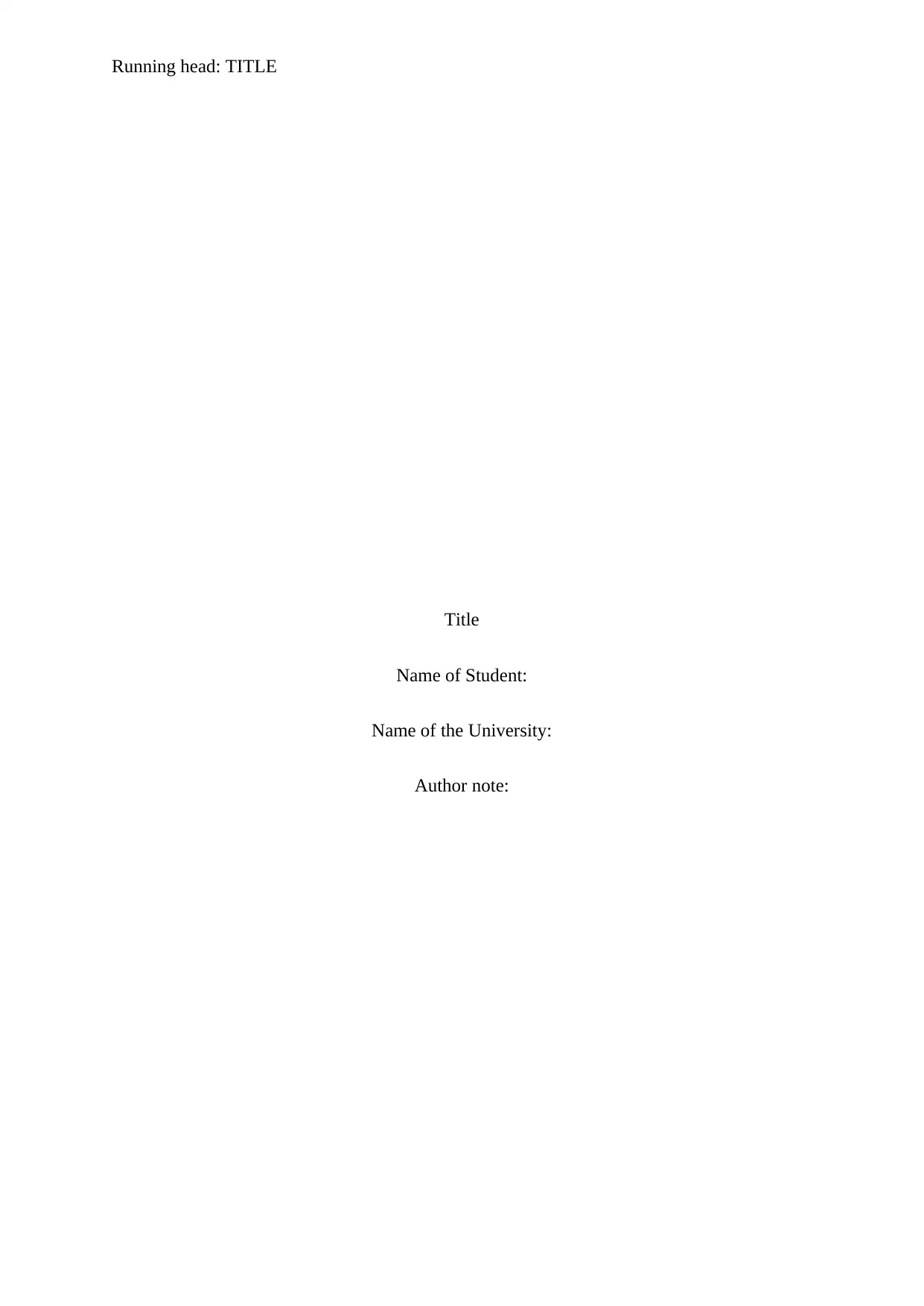
Running head: TITLE
Title
Name of Student:
Name of the University:
Author note:
Title
Name of Student:
Name of the University:
Author note:
Paraphrase This Document
Need a fresh take? Get an instant paraphrase of this document with our AI Paraphraser
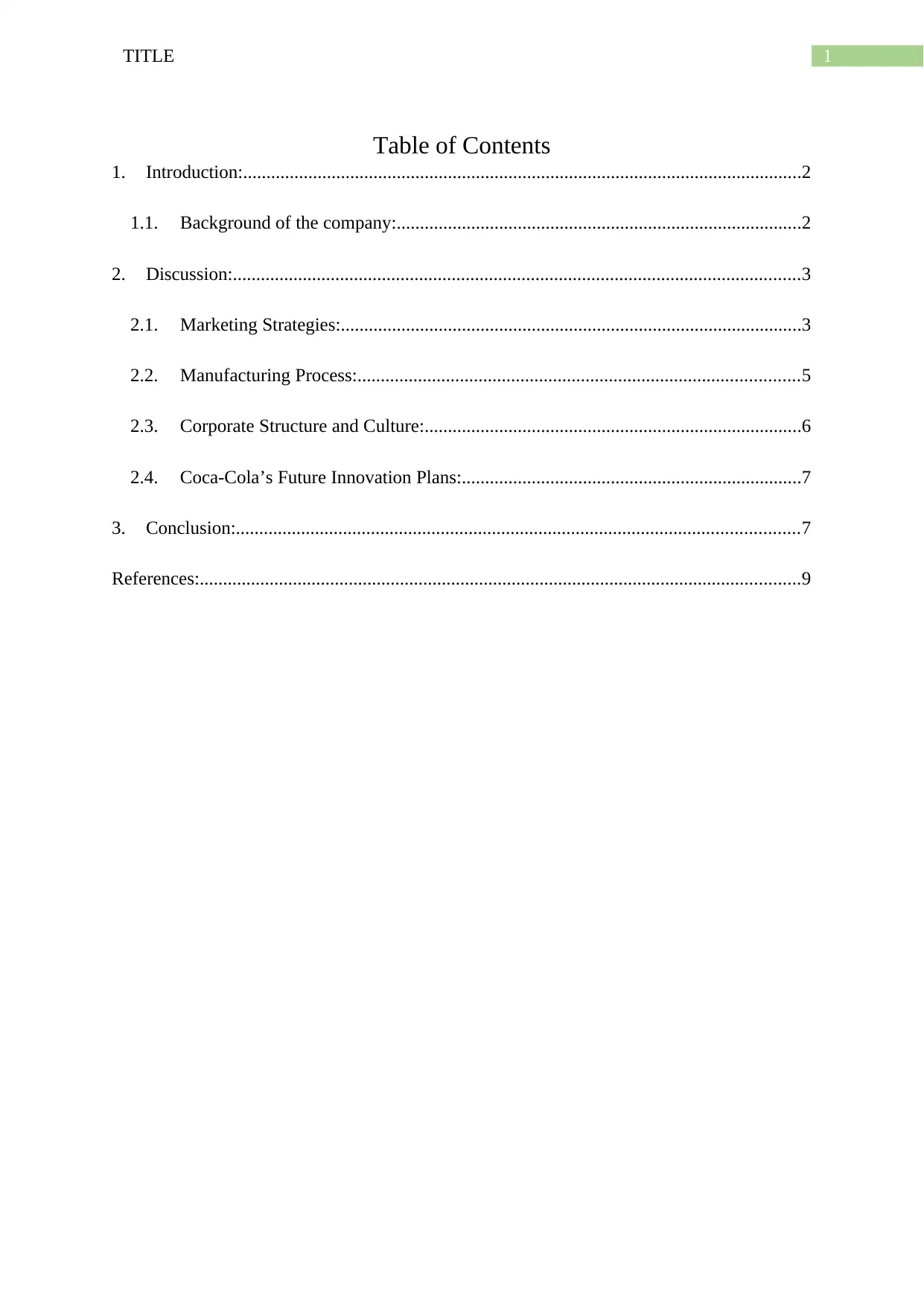
1TITLE
Table of Contents
1. Introduction:........................................................................................................................2
1.1. Background of the company:.......................................................................................2
2. Discussion:..........................................................................................................................3
2.1. Marketing Strategies:...................................................................................................3
2.2. Manufacturing Process:...............................................................................................5
2.3. Corporate Structure and Culture:.................................................................................6
2.4. Coca-Cola’s Future Innovation Plans:.........................................................................7
3. Conclusion:.........................................................................................................................7
References:.................................................................................................................................9
Table of Contents
1. Introduction:........................................................................................................................2
1.1. Background of the company:.......................................................................................2
2. Discussion:..........................................................................................................................3
2.1. Marketing Strategies:...................................................................................................3
2.2. Manufacturing Process:...............................................................................................5
2.3. Corporate Structure and Culture:.................................................................................6
2.4. Coca-Cola’s Future Innovation Plans:.........................................................................7
3. Conclusion:.........................................................................................................................7
References:.................................................................................................................................9
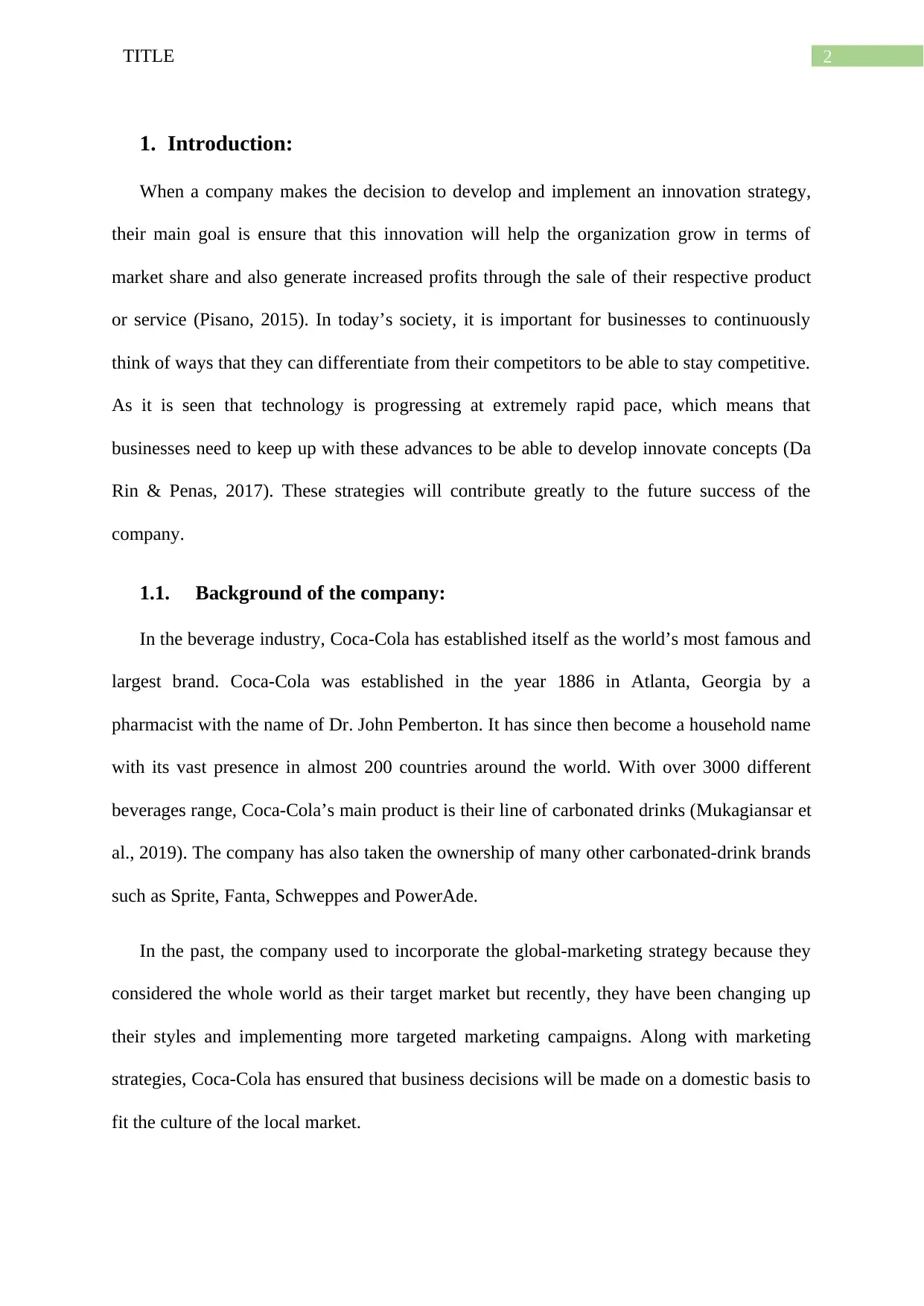
2TITLE
1. Introduction:
When a company makes the decision to develop and implement an innovation strategy,
their main goal is ensure that this innovation will help the organization grow in terms of
market share and also generate increased profits through the sale of their respective product
or service (Pisano, 2015). In today’s society, it is important for businesses to continuously
think of ways that they can differentiate from their competitors to be able to stay competitive.
As it is seen that technology is progressing at extremely rapid pace, which means that
businesses need to keep up with these advances to be able to develop innovate concepts (Da
Rin & Penas, 2017). These strategies will contribute greatly to the future success of the
company.
1.1. Background of the company:
In the beverage industry, Coca-Cola has established itself as the world’s most famous and
largest brand. Coca-Cola was established in the year 1886 in Atlanta, Georgia by a
pharmacist with the name of Dr. John Pemberton. It has since then become a household name
with its vast presence in almost 200 countries around the world. With over 3000 different
beverages range, Coca-Cola’s main product is their line of carbonated drinks (Mukagiansar et
al., 2019). The company has also taken the ownership of many other carbonated-drink brands
such as Sprite, Fanta, Schweppes and PowerAde.
In the past, the company used to incorporate the global-marketing strategy because they
considered the whole world as their target market but recently, they have been changing up
their styles and implementing more targeted marketing campaigns. Along with marketing
strategies, Coca-Cola has ensured that business decisions will be made on a domestic basis to
fit the culture of the local market.
1. Introduction:
When a company makes the decision to develop and implement an innovation strategy,
their main goal is ensure that this innovation will help the organization grow in terms of
market share and also generate increased profits through the sale of their respective product
or service (Pisano, 2015). In today’s society, it is important for businesses to continuously
think of ways that they can differentiate from their competitors to be able to stay competitive.
As it is seen that technology is progressing at extremely rapid pace, which means that
businesses need to keep up with these advances to be able to develop innovate concepts (Da
Rin & Penas, 2017). These strategies will contribute greatly to the future success of the
company.
1.1. Background of the company:
In the beverage industry, Coca-Cola has established itself as the world’s most famous and
largest brand. Coca-Cola was established in the year 1886 in Atlanta, Georgia by a
pharmacist with the name of Dr. John Pemberton. It has since then become a household name
with its vast presence in almost 200 countries around the world. With over 3000 different
beverages range, Coca-Cola’s main product is their line of carbonated drinks (Mukagiansar et
al., 2019). The company has also taken the ownership of many other carbonated-drink brands
such as Sprite, Fanta, Schweppes and PowerAde.
In the past, the company used to incorporate the global-marketing strategy because they
considered the whole world as their target market but recently, they have been changing up
their styles and implementing more targeted marketing campaigns. Along with marketing
strategies, Coca-Cola has ensured that business decisions will be made on a domestic basis to
fit the culture of the local market.
⊘ This is a preview!⊘
Do you want full access?
Subscribe today to unlock all pages.

Trusted by 1+ million students worldwide
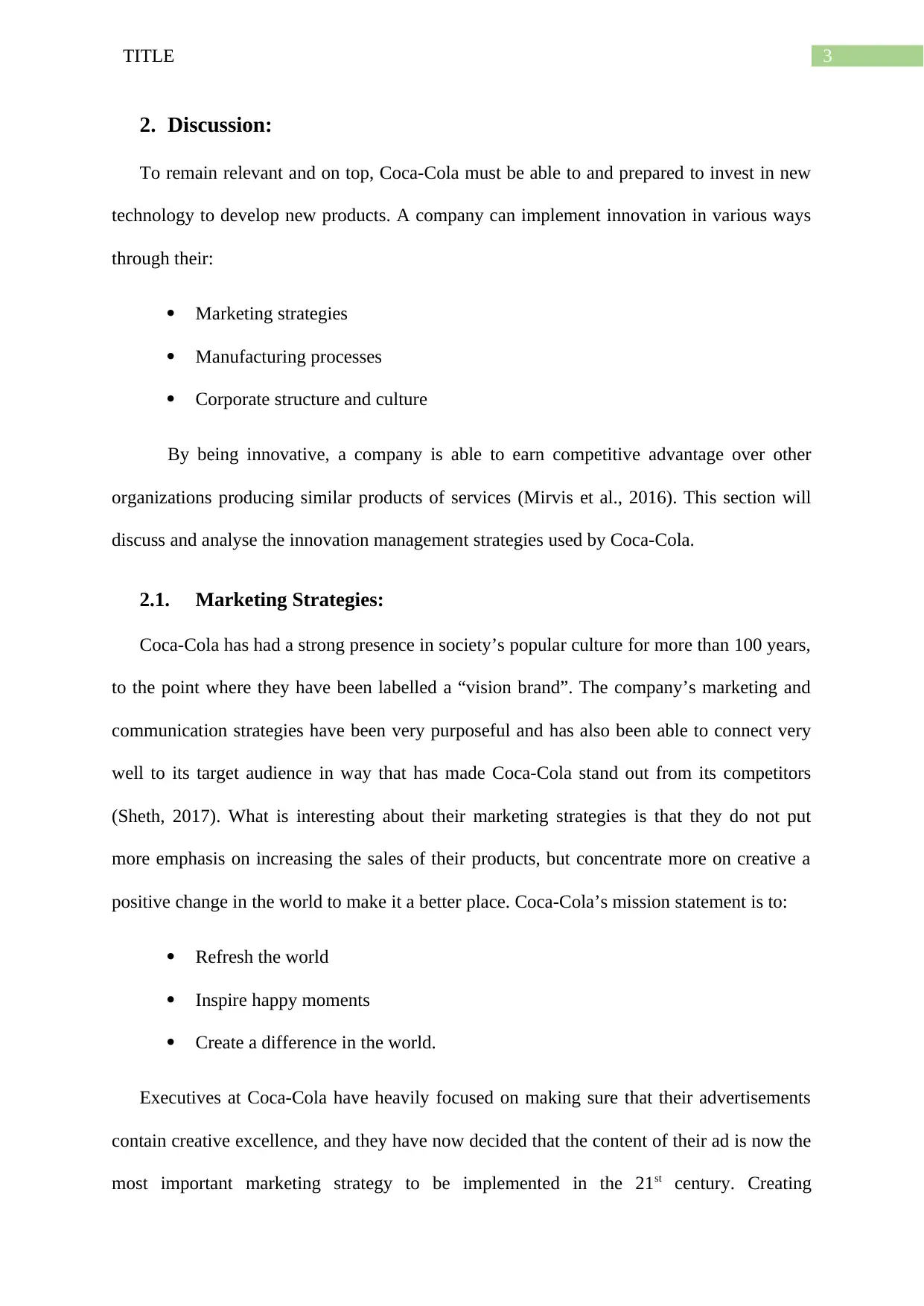
3TITLE
2. Discussion:
To remain relevant and on top, Coca-Cola must be able to and prepared to invest in new
technology to develop new products. A company can implement innovation in various ways
through their:
Marketing strategies
Manufacturing processes
Corporate structure and culture
By being innovative, a company is able to earn competitive advantage over other
organizations producing similar products of services (Mirvis et al., 2016). This section will
discuss and analyse the innovation management strategies used by Coca-Cola.
2.1. Marketing Strategies:
Coca-Cola has had a strong presence in society’s popular culture for more than 100 years,
to the point where they have been labelled a “vision brand”. The company’s marketing and
communication strategies have been very purposeful and has also been able to connect very
well to its target audience in way that has made Coca-Cola stand out from its competitors
(Sheth, 2017). What is interesting about their marketing strategies is that they do not put
more emphasis on increasing the sales of their products, but concentrate more on creative a
positive change in the world to make it a better place. Coca-Cola’s mission statement is to:
Refresh the world
Inspire happy moments
Create a difference in the world.
Executives at Coca-Cola have heavily focused on making sure that their advertisements
contain creative excellence, and they have now decided that the content of their ad is now the
most important marketing strategy to be implemented in the 21st century. Creating
2. Discussion:
To remain relevant and on top, Coca-Cola must be able to and prepared to invest in new
technology to develop new products. A company can implement innovation in various ways
through their:
Marketing strategies
Manufacturing processes
Corporate structure and culture
By being innovative, a company is able to earn competitive advantage over other
organizations producing similar products of services (Mirvis et al., 2016). This section will
discuss and analyse the innovation management strategies used by Coca-Cola.
2.1. Marketing Strategies:
Coca-Cola has had a strong presence in society’s popular culture for more than 100 years,
to the point where they have been labelled a “vision brand”. The company’s marketing and
communication strategies have been very purposeful and has also been able to connect very
well to its target audience in way that has made Coca-Cola stand out from its competitors
(Sheth, 2017). What is interesting about their marketing strategies is that they do not put
more emphasis on increasing the sales of their products, but concentrate more on creative a
positive change in the world to make it a better place. Coca-Cola’s mission statement is to:
Refresh the world
Inspire happy moments
Create a difference in the world.
Executives at Coca-Cola have heavily focused on making sure that their advertisements
contain creative excellence, and they have now decided that the content of their ad is now the
most important marketing strategy to be implemented in the 21st century. Creating
Paraphrase This Document
Need a fresh take? Get an instant paraphrase of this document with our AI Paraphraser
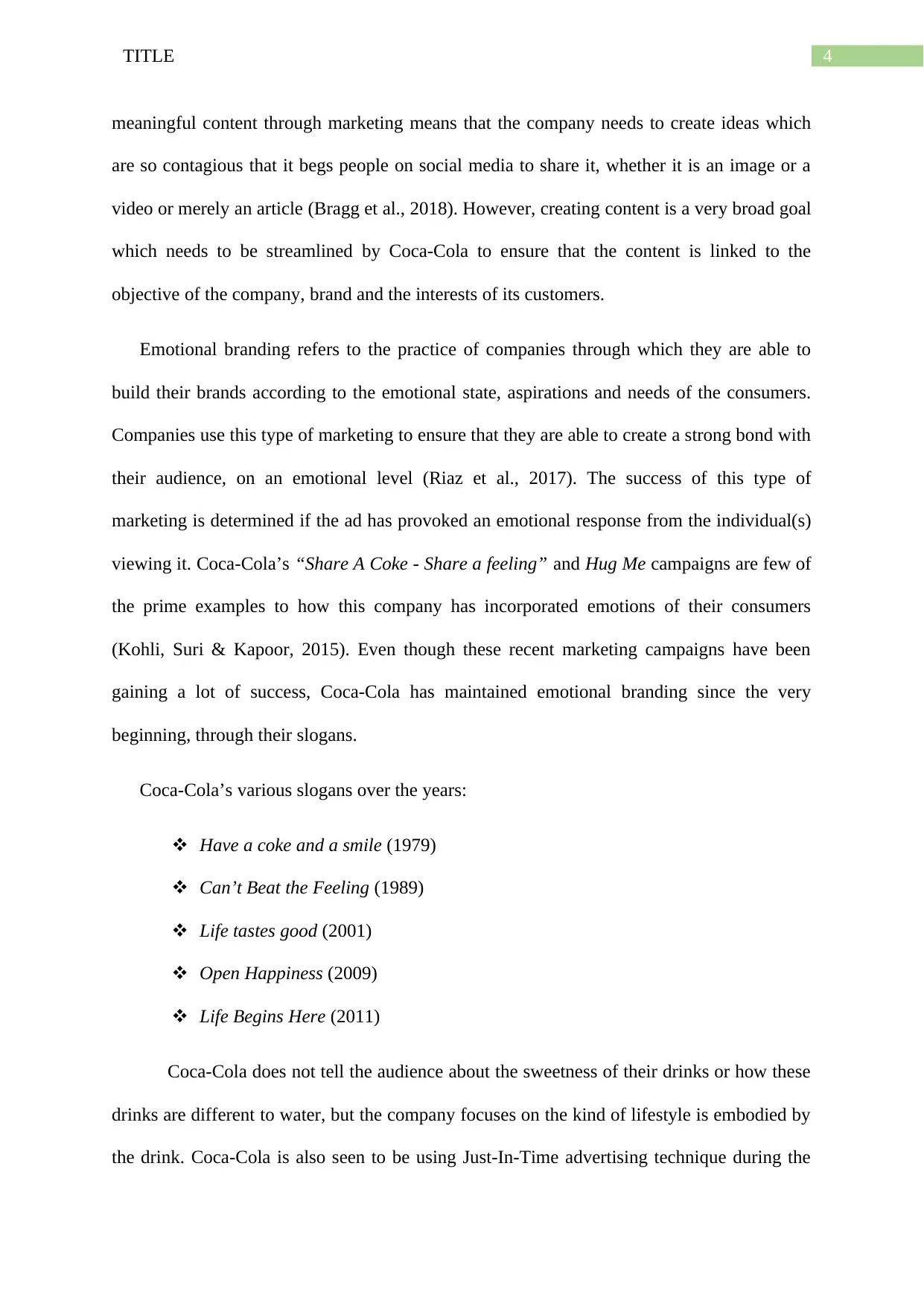
4TITLE
meaningful content through marketing means that the company needs to create ideas which
are so contagious that it begs people on social media to share it, whether it is an image or a
video or merely an article (Bragg et al., 2018). However, creating content is a very broad goal
which needs to be streamlined by Coca-Cola to ensure that the content is linked to the
objective of the company, brand and the interests of its customers.
Emotional branding refers to the practice of companies through which they are able to
build their brands according to the emotional state, aspirations and needs of the consumers.
Companies use this type of marketing to ensure that they are able to create a strong bond with
their audience, on an emotional level (Riaz et al., 2017). The success of this type of
marketing is determined if the ad has provoked an emotional response from the individual(s)
viewing it. Coca-Cola’s “Share A Coke - Share a feeling” and Hug Me campaigns are few of
the prime examples to how this company has incorporated emotions of their consumers
(Kohli, Suri & Kapoor, 2015). Even though these recent marketing campaigns have been
gaining a lot of success, Coca-Cola has maintained emotional branding since the very
beginning, through their slogans.
Coca-Cola’s various slogans over the years:
Have a coke and a smile (1979)
Can’t Beat the Feeling (1989)
Life tastes good (2001)
Open Happiness (2009)
Life Begins Here (2011)
Coca-Cola does not tell the audience about the sweetness of their drinks or how these
drinks are different to water, but the company focuses on the kind of lifestyle is embodied by
the drink. Coca-Cola is also seen to be using Just-In-Time advertising technique during the
meaningful content through marketing means that the company needs to create ideas which
are so contagious that it begs people on social media to share it, whether it is an image or a
video or merely an article (Bragg et al., 2018). However, creating content is a very broad goal
which needs to be streamlined by Coca-Cola to ensure that the content is linked to the
objective of the company, brand and the interests of its customers.
Emotional branding refers to the practice of companies through which they are able to
build their brands according to the emotional state, aspirations and needs of the consumers.
Companies use this type of marketing to ensure that they are able to create a strong bond with
their audience, on an emotional level (Riaz et al., 2017). The success of this type of
marketing is determined if the ad has provoked an emotional response from the individual(s)
viewing it. Coca-Cola’s “Share A Coke - Share a feeling” and Hug Me campaigns are few of
the prime examples to how this company has incorporated emotions of their consumers
(Kohli, Suri & Kapoor, 2015). Even though these recent marketing campaigns have been
gaining a lot of success, Coca-Cola has maintained emotional branding since the very
beginning, through their slogans.
Coca-Cola’s various slogans over the years:
Have a coke and a smile (1979)
Can’t Beat the Feeling (1989)
Life tastes good (2001)
Open Happiness (2009)
Life Begins Here (2011)
Coca-Cola does not tell the audience about the sweetness of their drinks or how these
drinks are different to water, but the company focuses on the kind of lifestyle is embodied by
the drink. Coca-Cola is also seen to be using Just-In-Time advertising technique during the
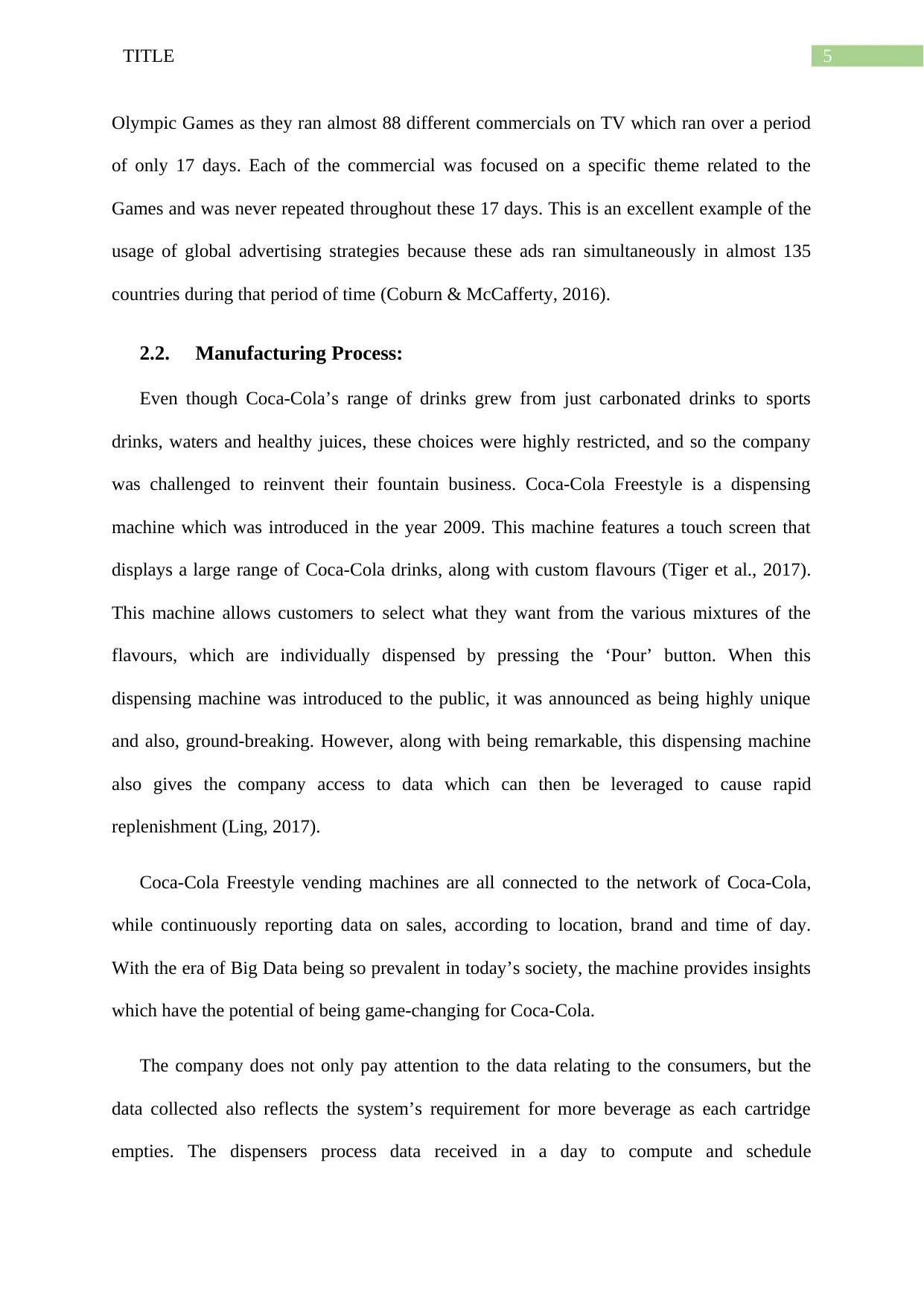
5TITLE
Olympic Games as they ran almost 88 different commercials on TV which ran over a period
of only 17 days. Each of the commercial was focused on a specific theme related to the
Games and was never repeated throughout these 17 days. This is an excellent example of the
usage of global advertising strategies because these ads ran simultaneously in almost 135
countries during that period of time (Coburn & McCafferty, 2016).
2.2. Manufacturing Process:
Even though Coca-Cola’s range of drinks grew from just carbonated drinks to sports
drinks, waters and healthy juices, these choices were highly restricted, and so the company
was challenged to reinvent their fountain business. Coca-Cola Freestyle is a dispensing
machine which was introduced in the year 2009. This machine features a touch screen that
displays a large range of Coca-Cola drinks, along with custom flavours (Tiger et al., 2017).
This machine allows customers to select what they want from the various mixtures of the
flavours, which are individually dispensed by pressing the ‘Pour’ button. When this
dispensing machine was introduced to the public, it was announced as being highly unique
and also, ground-breaking. However, along with being remarkable, this dispensing machine
also gives the company access to data which can then be leveraged to cause rapid
replenishment (Ling, 2017).
Coca-Cola Freestyle vending machines are all connected to the network of Coca-Cola,
while continuously reporting data on sales, according to location, brand and time of day.
With the era of Big Data being so prevalent in today’s society, the machine provides insights
which have the potential of being game-changing for Coca-Cola.
The company does not only pay attention to the data relating to the consumers, but the
data collected also reflects the system’s requirement for more beverage as each cartridge
empties. The dispensers process data received in a day to compute and schedule
Olympic Games as they ran almost 88 different commercials on TV which ran over a period
of only 17 days. Each of the commercial was focused on a specific theme related to the
Games and was never repeated throughout these 17 days. This is an excellent example of the
usage of global advertising strategies because these ads ran simultaneously in almost 135
countries during that period of time (Coburn & McCafferty, 2016).
2.2. Manufacturing Process:
Even though Coca-Cola’s range of drinks grew from just carbonated drinks to sports
drinks, waters and healthy juices, these choices were highly restricted, and so the company
was challenged to reinvent their fountain business. Coca-Cola Freestyle is a dispensing
machine which was introduced in the year 2009. This machine features a touch screen that
displays a large range of Coca-Cola drinks, along with custom flavours (Tiger et al., 2017).
This machine allows customers to select what they want from the various mixtures of the
flavours, which are individually dispensed by pressing the ‘Pour’ button. When this
dispensing machine was introduced to the public, it was announced as being highly unique
and also, ground-breaking. However, along with being remarkable, this dispensing machine
also gives the company access to data which can then be leveraged to cause rapid
replenishment (Ling, 2017).
Coca-Cola Freestyle vending machines are all connected to the network of Coca-Cola,
while continuously reporting data on sales, according to location, brand and time of day.
With the era of Big Data being so prevalent in today’s society, the machine provides insights
which have the potential of being game-changing for Coca-Cola.
The company does not only pay attention to the data relating to the consumers, but the
data collected also reflects the system’s requirement for more beverage as each cartridge
empties. The dispensers process data received in a day to compute and schedule
⊘ This is a preview!⊘
Do you want full access?
Subscribe today to unlock all pages.

Trusted by 1+ million students worldwide
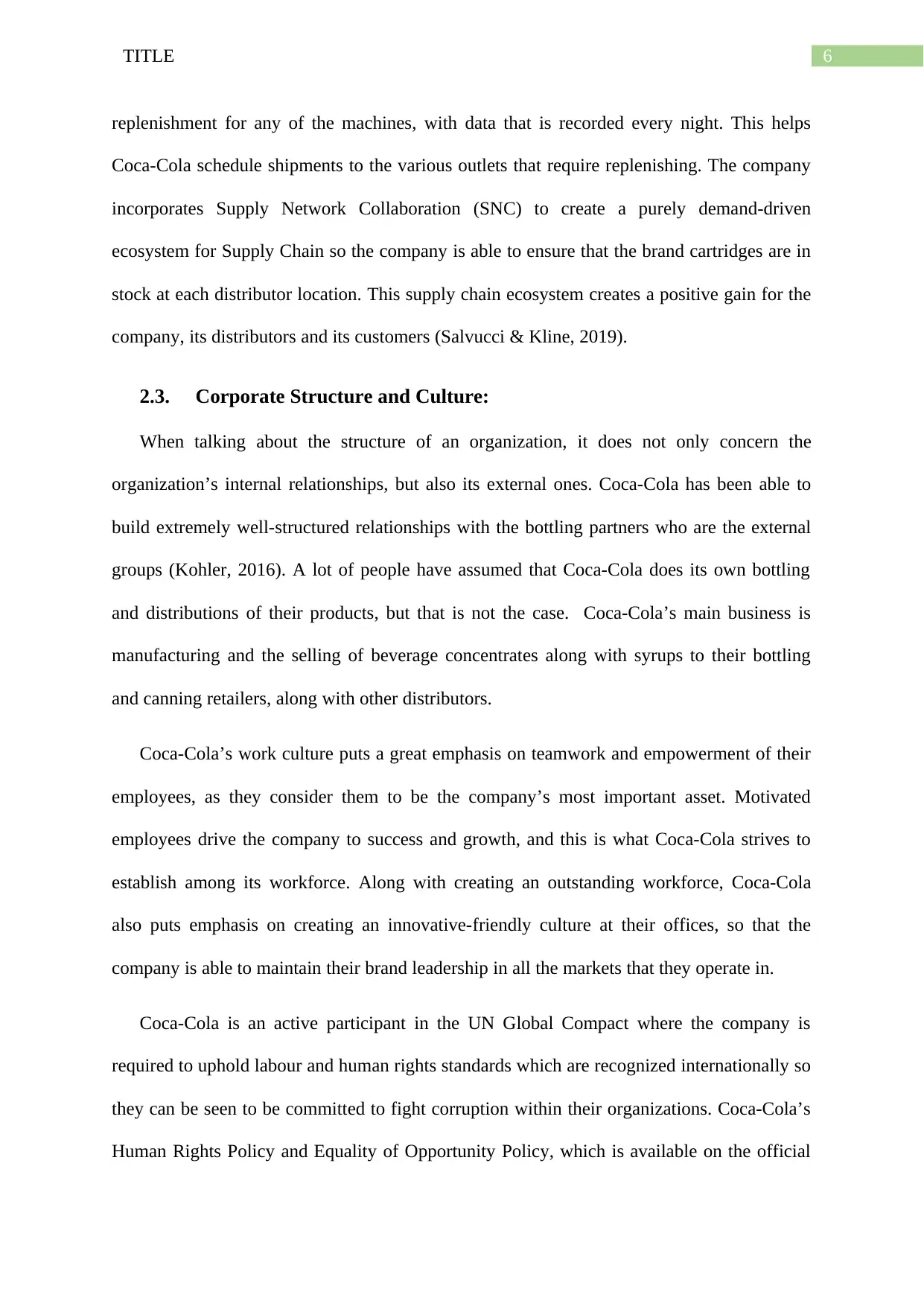
6TITLE
replenishment for any of the machines, with data that is recorded every night. This helps
Coca-Cola schedule shipments to the various outlets that require replenishing. The company
incorporates Supply Network Collaboration (SNC) to create a purely demand-driven
ecosystem for Supply Chain so the company is able to ensure that the brand cartridges are in
stock at each distributor location. This supply chain ecosystem creates a positive gain for the
company, its distributors and its customers (Salvucci & Kline, 2019).
2.3. Corporate Structure and Culture:
When talking about the structure of an organization, it does not only concern the
organization’s internal relationships, but also its external ones. Coca-Cola has been able to
build extremely well-structured relationships with the bottling partners who are the external
groups (Kohler, 2016). A lot of people have assumed that Coca-Cola does its own bottling
and distributions of their products, but that is not the case. Coca-Cola’s main business is
manufacturing and the selling of beverage concentrates along with syrups to their bottling
and canning retailers, along with other distributors.
Coca-Cola’s work culture puts a great emphasis on teamwork and empowerment of their
employees, as they consider them to be the company’s most important asset. Motivated
employees drive the company to success and growth, and this is what Coca-Cola strives to
establish among its workforce. Along with creating an outstanding workforce, Coca-Cola
also puts emphasis on creating an innovative-friendly culture at their offices, so that the
company is able to maintain their brand leadership in all the markets that they operate in.
Coca-Cola is an active participant in the UN Global Compact where the company is
required to uphold labour and human rights standards which are recognized internationally so
they can be seen to be committed to fight corruption within their organizations. Coca-Cola’s
Human Rights Policy and Equality of Opportunity Policy, which is available on the official
replenishment for any of the machines, with data that is recorded every night. This helps
Coca-Cola schedule shipments to the various outlets that require replenishing. The company
incorporates Supply Network Collaboration (SNC) to create a purely demand-driven
ecosystem for Supply Chain so the company is able to ensure that the brand cartridges are in
stock at each distributor location. This supply chain ecosystem creates a positive gain for the
company, its distributors and its customers (Salvucci & Kline, 2019).
2.3. Corporate Structure and Culture:
When talking about the structure of an organization, it does not only concern the
organization’s internal relationships, but also its external ones. Coca-Cola has been able to
build extremely well-structured relationships with the bottling partners who are the external
groups (Kohler, 2016). A lot of people have assumed that Coca-Cola does its own bottling
and distributions of their products, but that is not the case. Coca-Cola’s main business is
manufacturing and the selling of beverage concentrates along with syrups to their bottling
and canning retailers, along with other distributors.
Coca-Cola’s work culture puts a great emphasis on teamwork and empowerment of their
employees, as they consider them to be the company’s most important asset. Motivated
employees drive the company to success and growth, and this is what Coca-Cola strives to
establish among its workforce. Along with creating an outstanding workforce, Coca-Cola
also puts emphasis on creating an innovative-friendly culture at their offices, so that the
company is able to maintain their brand leadership in all the markets that they operate in.
Coca-Cola is an active participant in the UN Global Compact where the company is
required to uphold labour and human rights standards which are recognized internationally so
they can be seen to be committed to fight corruption within their organizations. Coca-Cola’s
Human Rights Policy and Equality of Opportunity Policy, which is available on the official
Paraphrase This Document
Need a fresh take? Get an instant paraphrase of this document with our AI Paraphraser
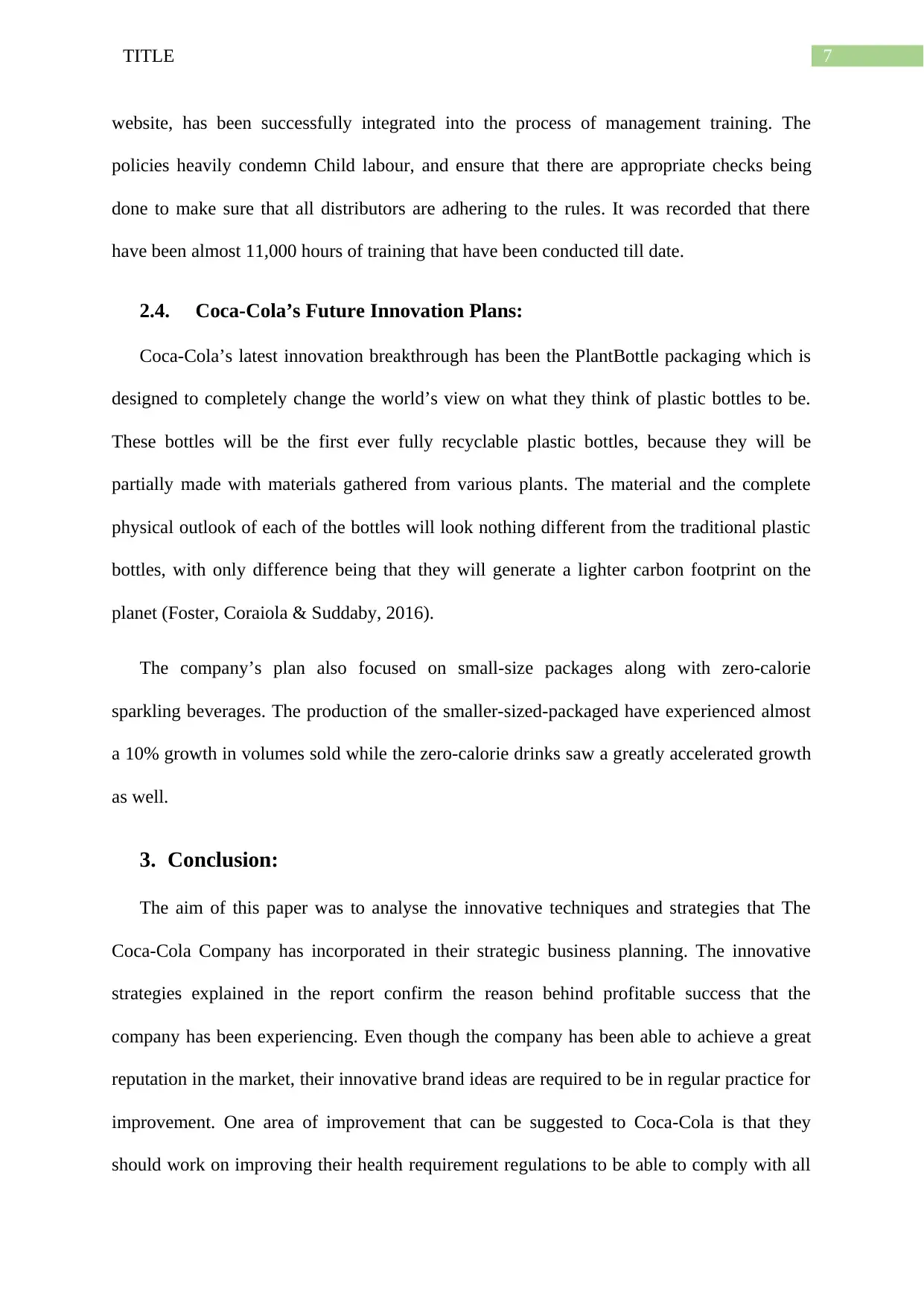
7TITLE
website, has been successfully integrated into the process of management training. The
policies heavily condemn Child labour, and ensure that there are appropriate checks being
done to make sure that all distributors are adhering to the rules. It was recorded that there
have been almost 11,000 hours of training that have been conducted till date.
2.4. Coca-Cola’s Future Innovation Plans:
Coca-Cola’s latest innovation breakthrough has been the PlantBottle packaging which is
designed to completely change the world’s view on what they think of plastic bottles to be.
These bottles will be the first ever fully recyclable plastic bottles, because they will be
partially made with materials gathered from various plants. The material and the complete
physical outlook of each of the bottles will look nothing different from the traditional plastic
bottles, with only difference being that they will generate a lighter carbon footprint on the
planet (Foster, Coraiola & Suddaby, 2016).
The company’s plan also focused on small-size packages along with zero-calorie
sparkling beverages. The production of the smaller-sized-packaged have experienced almost
a 10% growth in volumes sold while the zero-calorie drinks saw a greatly accelerated growth
as well.
3. Conclusion:
The aim of this paper was to analyse the innovative techniques and strategies that The
Coca-Cola Company has incorporated in their strategic business planning. The innovative
strategies explained in the report confirm the reason behind profitable success that the
company has been experiencing. Even though the company has been able to achieve a great
reputation in the market, their innovative brand ideas are required to be in regular practice for
improvement. One area of improvement that can be suggested to Coca-Cola is that they
should work on improving their health requirement regulations to be able to comply with all
website, has been successfully integrated into the process of management training. The
policies heavily condemn Child labour, and ensure that there are appropriate checks being
done to make sure that all distributors are adhering to the rules. It was recorded that there
have been almost 11,000 hours of training that have been conducted till date.
2.4. Coca-Cola’s Future Innovation Plans:
Coca-Cola’s latest innovation breakthrough has been the PlantBottle packaging which is
designed to completely change the world’s view on what they think of plastic bottles to be.
These bottles will be the first ever fully recyclable plastic bottles, because they will be
partially made with materials gathered from various plants. The material and the complete
physical outlook of each of the bottles will look nothing different from the traditional plastic
bottles, with only difference being that they will generate a lighter carbon footprint on the
planet (Foster, Coraiola & Suddaby, 2016).
The company’s plan also focused on small-size packages along with zero-calorie
sparkling beverages. The production of the smaller-sized-packaged have experienced almost
a 10% growth in volumes sold while the zero-calorie drinks saw a greatly accelerated growth
as well.
3. Conclusion:
The aim of this paper was to analyse the innovative techniques and strategies that The
Coca-Cola Company has incorporated in their strategic business planning. The innovative
strategies explained in the report confirm the reason behind profitable success that the
company has been experiencing. Even though the company has been able to achieve a great
reputation in the market, their innovative brand ideas are required to be in regular practice for
improvement. One area of improvement that can be suggested to Coca-Cola is that they
should work on improving their health requirement regulations to be able to comply with all
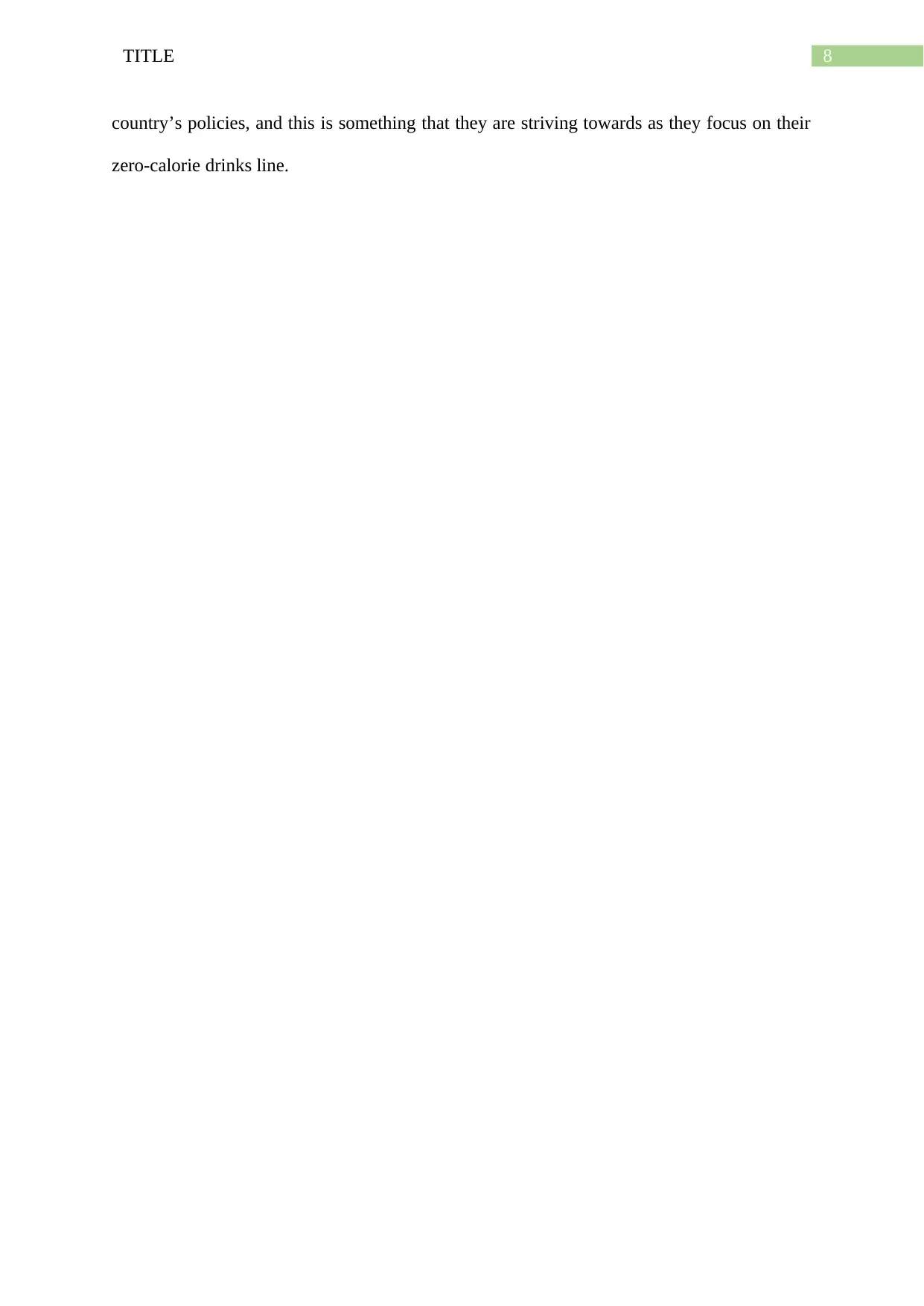
8TITLE
country’s policies, and this is something that they are striving towards as they focus on their
zero-calorie drinks line.
country’s policies, and this is something that they are striving towards as they focus on their
zero-calorie drinks line.
⊘ This is a preview!⊘
Do you want full access?
Subscribe today to unlock all pages.

Trusted by 1+ million students worldwide
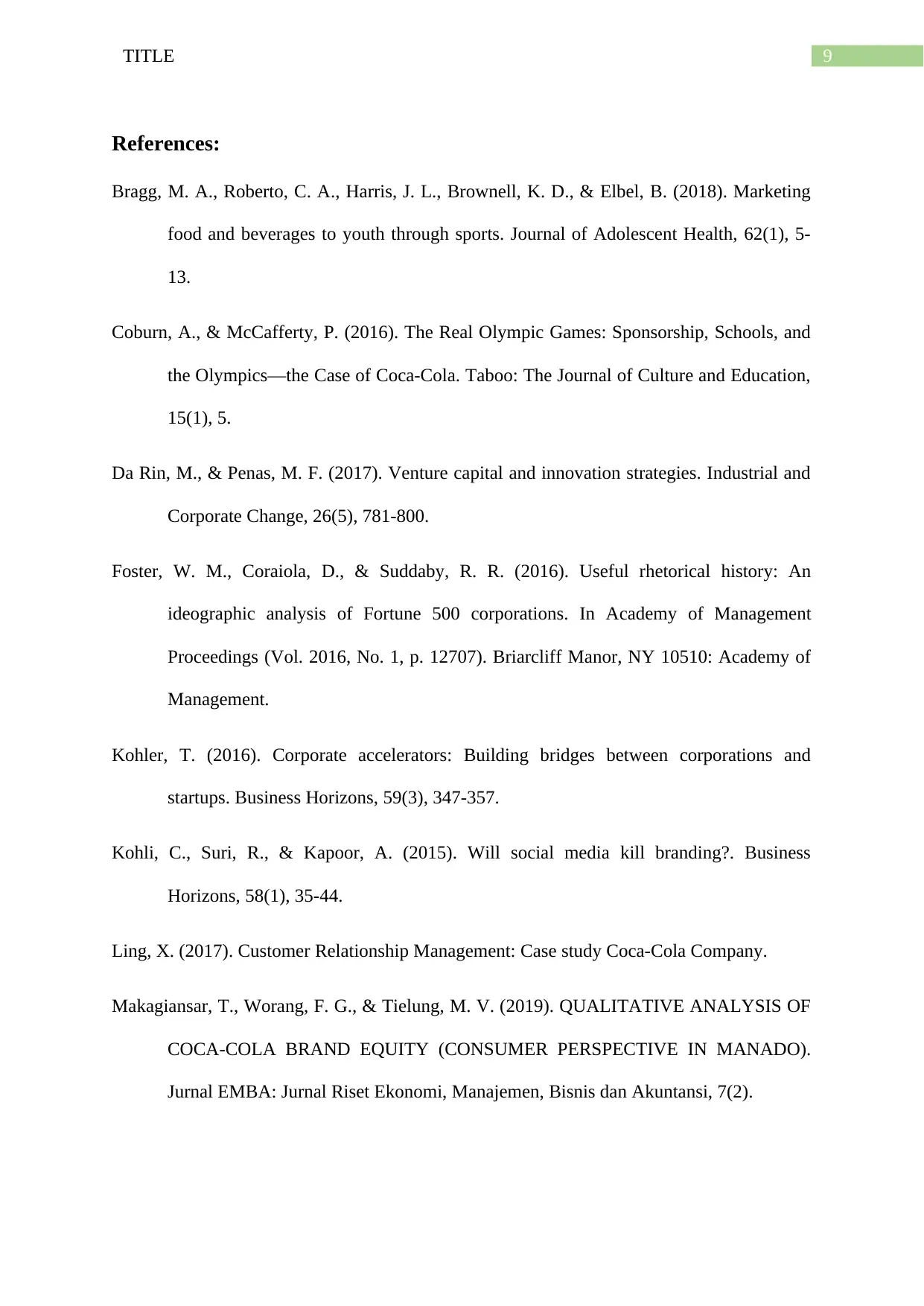
9TITLE
References:
Bragg, M. A., Roberto, C. A., Harris, J. L., Brownell, K. D., & Elbel, B. (2018). Marketing
food and beverages to youth through sports. Journal of Adolescent Health, 62(1), 5-
13.
Coburn, A., & McCafferty, P. (2016). The Real Olympic Games: Sponsorship, Schools, and
the Olympics—the Case of Coca-Cola. Taboo: The Journal of Culture and Education,
15(1), 5.
Da Rin, M., & Penas, M. F. (2017). Venture capital and innovation strategies. Industrial and
Corporate Change, 26(5), 781-800.
Foster, W. M., Coraiola, D., & Suddaby, R. R. (2016). Useful rhetorical history: An
ideographic analysis of Fortune 500 corporations. In Academy of Management
Proceedings (Vol. 2016, No. 1, p. 12707). Briarcliff Manor, NY 10510: Academy of
Management.
Kohler, T. (2016). Corporate accelerators: Building bridges between corporations and
startups. Business Horizons, 59(3), 347-357.
Kohli, C., Suri, R., & Kapoor, A. (2015). Will social media kill branding?. Business
Horizons, 58(1), 35-44.
Ling, X. (2017). Customer Relationship Management: Case study Coca-Cola Company.
Makagiansar, T., Worang, F. G., & Tielung, M. V. (2019). QUALITATIVE ANALYSIS OF
COCA-COLA BRAND EQUITY (CONSUMER PERSPECTIVE IN MANADO).
Jurnal EMBA: Jurnal Riset Ekonomi, Manajemen, Bisnis dan Akuntansi, 7(2).
References:
Bragg, M. A., Roberto, C. A., Harris, J. L., Brownell, K. D., & Elbel, B. (2018). Marketing
food and beverages to youth through sports. Journal of Adolescent Health, 62(1), 5-
13.
Coburn, A., & McCafferty, P. (2016). The Real Olympic Games: Sponsorship, Schools, and
the Olympics—the Case of Coca-Cola. Taboo: The Journal of Culture and Education,
15(1), 5.
Da Rin, M., & Penas, M. F. (2017). Venture capital and innovation strategies. Industrial and
Corporate Change, 26(5), 781-800.
Foster, W. M., Coraiola, D., & Suddaby, R. R. (2016). Useful rhetorical history: An
ideographic analysis of Fortune 500 corporations. In Academy of Management
Proceedings (Vol. 2016, No. 1, p. 12707). Briarcliff Manor, NY 10510: Academy of
Management.
Kohler, T. (2016). Corporate accelerators: Building bridges between corporations and
startups. Business Horizons, 59(3), 347-357.
Kohli, C., Suri, R., & Kapoor, A. (2015). Will social media kill branding?. Business
Horizons, 58(1), 35-44.
Ling, X. (2017). Customer Relationship Management: Case study Coca-Cola Company.
Makagiansar, T., Worang, F. G., & Tielung, M. V. (2019). QUALITATIVE ANALYSIS OF
COCA-COLA BRAND EQUITY (CONSUMER PERSPECTIVE IN MANADO).
Jurnal EMBA: Jurnal Riset Ekonomi, Manajemen, Bisnis dan Akuntansi, 7(2).
Paraphrase This Document
Need a fresh take? Get an instant paraphrase of this document with our AI Paraphraser
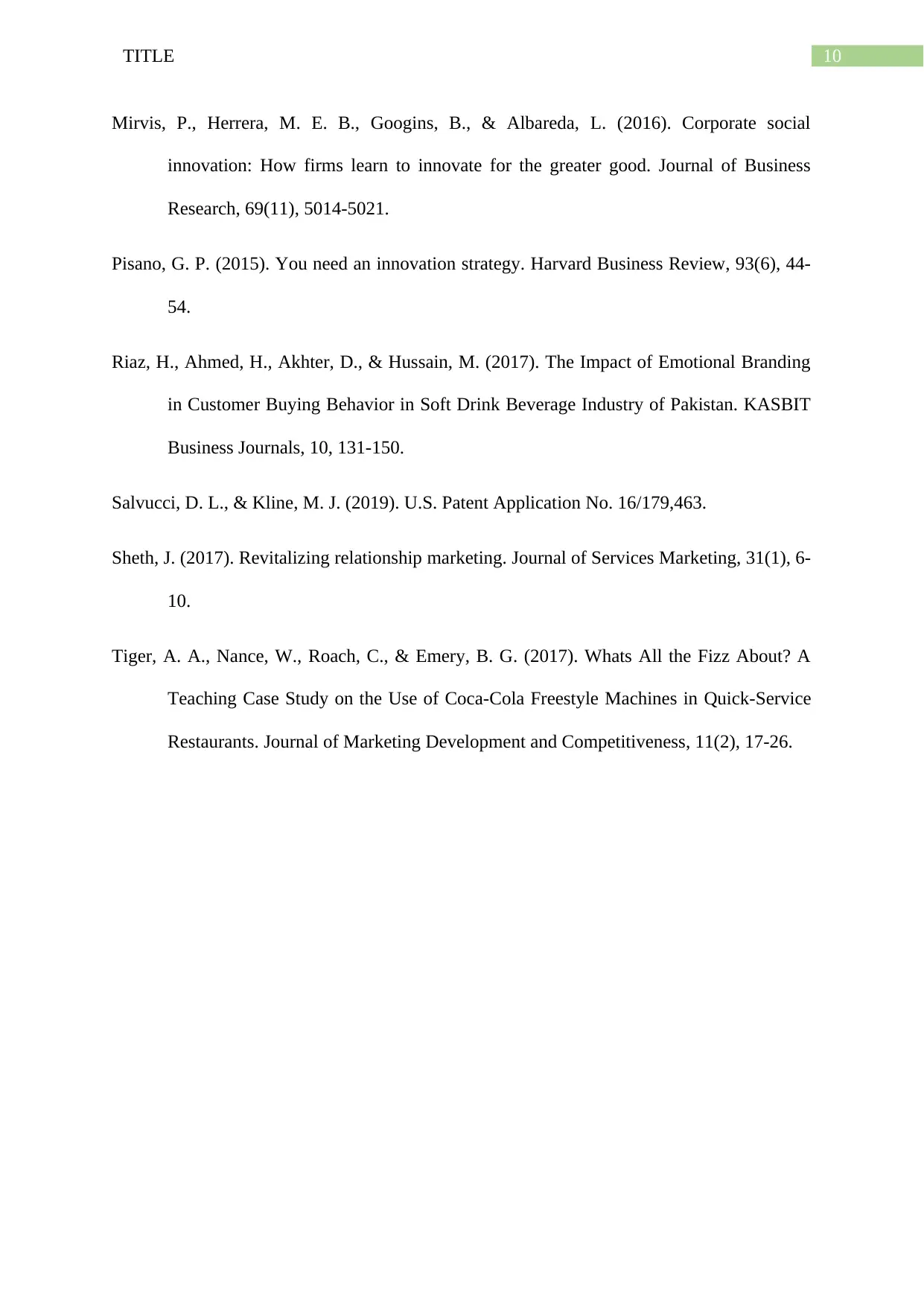
10TITLE
Mirvis, P., Herrera, M. E. B., Googins, B., & Albareda, L. (2016). Corporate social
innovation: How firms learn to innovate for the greater good. Journal of Business
Research, 69(11), 5014-5021.
Pisano, G. P. (2015). You need an innovation strategy. Harvard Business Review, 93(6), 44-
54.
Riaz, H., Ahmed, H., Akhter, D., & Hussain, M. (2017). The Impact of Emotional Branding
in Customer Buying Behavior in Soft Drink Beverage Industry of Pakistan. KASBIT
Business Journals, 10, 131-150.
Salvucci, D. L., & Kline, M. J. (2019). U.S. Patent Application No. 16/179,463.
Sheth, J. (2017). Revitalizing relationship marketing. Journal of Services Marketing, 31(1), 6-
10.
Tiger, A. A., Nance, W., Roach, C., & Emery, B. G. (2017). Whats All the Fizz About? A
Teaching Case Study on the Use of Coca-Cola Freestyle Machines in Quick-Service
Restaurants. Journal of Marketing Development and Competitiveness, 11(2), 17-26.
Mirvis, P., Herrera, M. E. B., Googins, B., & Albareda, L. (2016). Corporate social
innovation: How firms learn to innovate for the greater good. Journal of Business
Research, 69(11), 5014-5021.
Pisano, G. P. (2015). You need an innovation strategy. Harvard Business Review, 93(6), 44-
54.
Riaz, H., Ahmed, H., Akhter, D., & Hussain, M. (2017). The Impact of Emotional Branding
in Customer Buying Behavior in Soft Drink Beverage Industry of Pakistan. KASBIT
Business Journals, 10, 131-150.
Salvucci, D. L., & Kline, M. J. (2019). U.S. Patent Application No. 16/179,463.
Sheth, J. (2017). Revitalizing relationship marketing. Journal of Services Marketing, 31(1), 6-
10.
Tiger, A. A., Nance, W., Roach, C., & Emery, B. G. (2017). Whats All the Fizz About? A
Teaching Case Study on the Use of Coca-Cola Freestyle Machines in Quick-Service
Restaurants. Journal of Marketing Development and Competitiveness, 11(2), 17-26.
1 out of 11
Related Documents
Your All-in-One AI-Powered Toolkit for Academic Success.
+13062052269
info@desklib.com
Available 24*7 on WhatsApp / Email
![[object Object]](/_next/static/media/star-bottom.7253800d.svg)
Unlock your academic potential
Copyright © 2020–2025 A2Z Services. All Rights Reserved. Developed and managed by ZUCOL.




